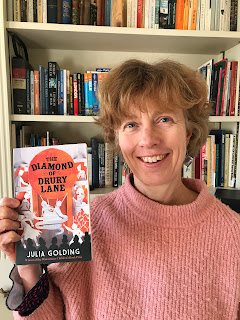It’s Lunar New Year, and this February the year
of the Tiger begins.
So I’m going to look at some of the ways in which animals
can embody our best and most exciting human qualities.
I grew up in Hong Kong, where Chinese New Year was
very exciting. We lived on a tiny island and we would visit everybody, dressed
in our best clothes. The lion dance called at every house, with cymbals and drums and the dancers capturing the playfulness of the friendly lion. Here's one from my local Chinese supermarket.
Each house had a beautiful table with peach blossom,
little orange trees and treats spread out. As children, adults gave us lucky
money red packets and lots of sweets. Here are a few things that I remember
from my childhood and can still find in London.
 |
Lucky money packet in the middle, for adults to give to children or younger people
|
Every year, beginning in either January or February, has an
animal. There are 12 altogether and each animal represents human
characteristics. They all have very positive qualities, even the ones that
sometimes get a negative press. Here they are in left-to-right, top-to-bottom
order. As you can see, they are all real animals except for the dragon, which here
is a benevolent and positive creature.
 |
Rat, Ox, Tiger, Rabbit, Dragon, Snake, Horse, Goat, Monkey, Rooster, Dog, Pig
|
Stories, myths and legends have always featured
animals that embody human qualities, for example Monkey and Pigsy in the Chinese
16th century novel Journey to the West, attributed to Wu Cheng’en. It’s
a much-loved story throughout the world.
 |
Tripitaka, Pigsy, Sandy and Sun Wukong, the Monkey king
|
And in ancient Greece, Aesop’s fables used
animals to reveal truths about people. This one shows the town mouse and the
country mouse.
 |
| Aesop's Fables adapted by Louis Untermeyer illustrated by A and M Provensen |
Of course animals have always featured large in
fantasy novels, but they find their way into historical fiction too. Often an
animal may be semi-magical or act as a messenger or guide. The Secret Garden by
Frances Hodgson Burnett was published in 1911 and set at the turn of the 20thcentury. She wrote two books about girls who had had to leave their home in
India and while they have also lost family, part of the story is the loss of
India and the coldness of England in comparison. The Secret Garden is a
realistic story about two abandoned children, but there is a robin who leads
Mary into a walled garden.
 |
Cover illustration for A Little Princess by George Smith, and for The Secret Garden by Angelo Rinaldi
|
In A Little Princess, the lonely and ill-treated Sarah is
befriended by a neighbour from India who sends his pet monkey across the roof
to make contact. In both these stories, the animals act as a reminder that in
spite of loss there are new friends and homes to be found. And crucially, it’s
the animals who bring people together.
The Crowfield novels by Pat Walsh are set in a
monastery in 14th century England.
 |
Covers by Steve Wells
|
The abbey and woods around it are also home to hobs, a
magical but very believable furry animal with a long tail. Brother Walter, the
hob, makes friends with William and although Will rescues him, his friendship
and otherworldly knowledge gives Will the courage he needs.
The Little White Horse is set in Victorian
England, when Maria moves to a beautiful but troubled valley.
 |
Cover by Debra McFarlane
|
In this story, there are very real animals like Maria’s
little dog, but also the elusive ‘horse’ of the title – who, with a shaggy dog,
is vital in restoring balance to the valley.
In these stories, the animals embody particular qualities:
hope in The Secret Garden, courage in The Crowfield Curse and reconciliation in
The Little White Horse. Through their presence, the protagonist can grow into
the best version of themselves and be able to make the changes they need. To some extent, their animal companion allows them to be fully human.
Writing challenge
Choose an animal. It can be a real one or a
magical one or one of the 12 animals of Chinese New Year. It might be very
large or tiny, able to swim or fly or run at lightning speed. Can this animal
talk? What gifts could this animal bring to help someone in a tricky situation?
Imagine your animal as a sidekick to the main character of a story – how would
the animal rescue them, or cheer them up or make them laugh? What would bring
the human character and their animal companion together in the first place?
One
Of Us by Jeannie Waudby is a YA thriller/love story, published by
Chicken House. It was shortlisted for the Bolton Children's Fiction
Award and the Lancashire Book of the Year 2016 and has been adapted by
Mike Kenny as a play in the Oxford Playscripts series.
One Of Us is published by Chicken House
The Oxford Playscripts play is published by Oxford University Press






























